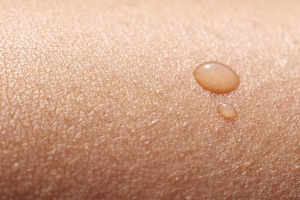Loading...
What is sweating?
Sweating (also called perspiration) is the production of a fluid, consisting primarily of water as well as various dissolved solids (chiefly chlorides), that is excreted by the sweat glands in the skin of mammals.
What are sweat glands?
The human body has 2-5 million sweat glands. These are small tubular structures in the skin that produce sweat.

These sweat glands are mainly of two types. The first are the 'eccrine' glands, which are distributed almost all over the body, though their density varies from region to region. These eccrine glands usually secrete clear, odourless sweat. We humans utilise these eccrine sweat glands as a primary form of cooling in response to temperature rise, in order to maintain the body temperature within the normal range.
The second type sweat glands are the “apocrine” glands that are larger and are mostly limited to the axilla (armpits) and perianal areas. The apocrine sweat glands have a different secretion mechanism, and secrete thicker sweat that is foul smelling. Although apocrine glands contribute little to cooling in humans, they are the only effective sweat glands in hoofed animals such as cattle, horse, donkey, camel etc.
There is a third variety of sweat glands that cannot be classified as either apocrine or eccrine. These glands have characteristics of both and are termed “apoeccrine” glands. These too are found in the armpits and perianal region and are presumed to have developed from the eccrine glands at puberty. These comprise up to 50% of all sweat glands in the armpits. Apoeccrine glands secrete more sweat than both eccrine and apocrine glands, thus playing a large role in axillary sweating. Like eccrine glands, they continuously secrete a thin, watery sweat.
Why do we sweat?
Sweating is an important bodily function that allows us to control our body temperature and keep it within the normal range. The average normal body temperature is 37oC (or 98.6oF).
The body heats up in response to stress (external heat, physical activity, emotional stress etc.)
Our brain has a temperature-regulating centre that helps us cool down and bring the temperature back to normal. Similarly, when the body temperature fall below the normal range, usually due to external cooling, the same centre helps us conserve body heat and warm up to the normal range. This process is called thermoregulation.
We all sweat as a normal response to different forms of stress (e.g. heat, exercise or emotional stress). However, some people sweat excessively or disproportionately to such stimulation. This condition is called hyperhidrosis.









